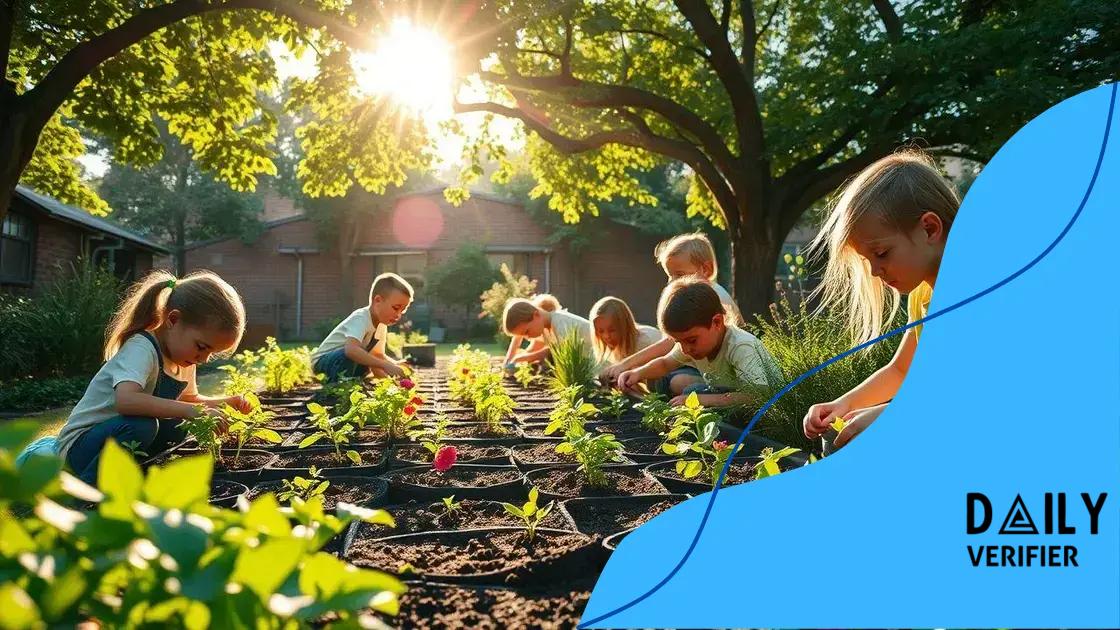Schools go green: how eco-friendly practices transform education

Schools can implement green initiatives, such as recycling programs and energy-efficient practices, which enhance the learning environment, improve student well-being, and promote sustainability within the community.
Strong>Schools go green is more than just a trend; it’s a vital shift towards a sustainable future. Imagine classrooms where students learn about nature by experiencing it firsthand. Curious about how this transformation can benefit our kids and the planet? Let’s dive in!
Understanding the green movement in schools
The green movement in schools is about creating an eco-friendly environment for learning and growth. It nurtures responsible citizenship among students while impacting the planet positively.
What is the Green Movement?
This movement focuses on sustainable practices aimed at reducing waste and conserving resources. By integrating these practices into education, schools help students learn the importance of taking care of their community and the Earth.
Key Factors of the Movement
- Environmental Education: Teaching kids about ecology fosters respect for nature.
- Sustainable Practices: Schools find ways to reduce energy consumption and waste.
- Community Involvement: Engaging local communities promotes a sense of responsibility.
Many schools are now utilizing recycling programs, which not only cut down on waste but also teach students the value of reusing materials. Another popular initiative is the introduction of green spaces on school grounds, like gardens, where students can learn about plants and biodiversity.
In addition, integrating eco-friendly materials into classrooms makes a significant impact. For example, using recycled paper and non-toxic supplies helps to ensure a healthier environment for everyone.
Benefits for Students
The green movement empowers students to be proactive about environmental issues. This engagement leads to improved critical thinking skills, teamwork, and a greater understanding of global challenges. When students participate in green projects, they build valuable skills that translate to real-world applications, making learning meaningful.
Benefits of going green for students
The benefits of going green for students are numerous and impactful. By adopting eco-friendly practices, schools not only teach responsibility but also enhance the overall educational experience.
Academic Improvement
Research shows that green schools lead to better academic performance. When students are in a healthy, sustainable environment, they tend to focus more and achieve higher grades.
Physical and Mental Health
Exposure to natural light and clean air improves students’ mental clarity and reduces stress. Green spaces around schools encourage physical activity, which is crucial for a student’s overall well-being.
- Improved Concentration: Open and well-ventilated spaces help students stay engaged.
- Lower Stress Levels: Natural environments reduce anxiety among students.
- Health Benefits: Access to outdoor environments promotes exercise and healthy lifestyle choices.
Moreover, as students actively participate in environmental initiatives, they develop teamwork and leadership skills. Collaborating on projects, like school gardens or recycling programs, fosters a sense of community and belonging.
Learning about sustainability also prepares students for future careers in a green economy. They gain knowledge that is not only relevant today but will be invaluable in their future endeavors. Engaging in hands-on activities, like building a compost bin or working with local farms, helps them understand their role in the environment.
Eco-friendly practices every school can adopt

There are many eco-friendly practices that schools can adopt to promote sustainability and environmental awareness among students. These practices not only benefit the planet but also create a better learning environment.
Recycling Programs
Implementing a recycling program is one of the simplest ways schools can go green. By encouraging students to recycle paper, plastics, and electronics, schools can significantly reduce waste while teaching students the importance of recycling.
Energy Efficiency Measures
Energy-efficient lighting, like LED bulbs, helps schools save on electricity costs while promoting sustainability. Additionally, schools can encourage students to turn off lights and electronics when not in use to further conserve energy.
- Solar Panels: Installing solar panels can reduce energy bills and promote renewable energy use.
- Green Roofs: These can improve insulation and create habitats for birds and insects.
- Energy Audits: Regular audits can help identify areas for improvement in energy usage.
Creating a school garden is another effective practice. This not only enhances the schoolyard but allows students to learn about growing their own food and the importance of local ecosystems. In the garden, students practice sustainability by composting food scraps and using organic gardening methods.
Another practice is integrating environmental education into the curriculum. Lessons on climate change, conservation, and biodiversity raise awareness and inspire actions that students can take to protect the planet.
Green Transportation Options
Encouraging students to walk, bike, or use public transportation can significantly reduce carbon footprints. Schools could even create walking school buses where groups of students walk together with adult supervision, promoting safety and environmental consciousness.
Real-world examples of green schools
Many schools across the globe serve as shining examples of how to implement green initiatives effectively. These schools not only focus on sustainability but also engage students in meaningful ways.
The Green School, Bali
Located in Indonesia, The Green School is built entirely from bamboo and features a strong emphasis on sustainability. Students here learn about the environment through hands-on projects like permaculture, where they grow their own food.
High Tech High, California
High Tech High integrates green technology into its curriculum. The school features energy-efficient buildings and promotes project-based learning. Students often work on real-world problems, such as designing sustainable energy sources for their community.
- Innovative Classrooms: Classrooms encourage collaboration and connectivity.
- Green Roofs: These provide insulation and habitats for wildlife.
- Community Projects: Students engage in local environmental initiatives.
Springhill Elementary in Mississippi is another great example. The school converted its grounds into a natural habitat, providing students with a living classroom. They learn about local wildlife and ecosystems right in their own backyard. This hands-on experience fosters a love for nature and science.
Moreover, many schools in Germany focus on environmental education. They encourage students to use public transportation and practice sustainability at home, leading to a more responsible generation. Through regular workshops and interactive learning, these students become advocates for a cleaner planet.
Impacts of Green Schools
Green schools show that sustainable practices improve student focus and well-being. As students engage with these practices, they often excel academically and become motivated to continue advocating for the environment outside of school.
Challenges and solutions in implementing green initiatives
Implementing green initiatives in schools can present several challenges. However, with proper strategies and community support, many of these obstacles can be overcome.
Common Challenges
One primary challenge is funding. Many schools struggle to secure financial resources for green projects. Without adequate funds, it’s difficult to implement sustainable technologies and programs. Additionally, there can be resistance to change from staff and administration who may be accustomed to traditional practices.
Awareness and Education
Another challenge is a lack of awareness about environmental issues. Some students and staff may not recognize the importance of sustainability. This can lead to minimal participation in green programs and initiatives.
- Limited Resources: Schools may have few materials or staff trained in sustainability.
- Compliance Regulations: Navigating laws and regulations can be complex.
- Community Engagement: Difficulty connecting with families and local organizations may hinder project success.
To address these challenges, schools can seek grants from environmental organizations. Many nonprofits offer funding and resources specifically for educational institutions to implement green solutions.
Creating partnerships with local businesses can also be valuable. These businesses might provide materials or expertise needed for projects. Collaborations can raise awareness and foster community support for sustainability efforts.
Education and Training
Increasing knowledge about sustainability among staff and students is essential. Schools can hold workshops to educate everyone on the importance of going green. Engaging students through hands-on projects, like recycling programs and eco-clubs, can also motivate participation.
Moreover, integrating environmental topics into the curriculum ensures ongoing education in sustainability. When students learn about these issues in science class, they become more invested in their school’s green initiatives.
FAQ – Frequently Asked Questions about Green Initiatives in Schools
What are the main challenges schools face when going green?
Common challenges include securing funding, raising awareness among students and staff, and overcoming resistance to change.
How can schools fund their green initiatives?
Schools can seek grants from environmental organizations, form partnerships with local businesses, and implement fundraising strategies to support green projects.
Why is student engagement important in sustainability efforts?
Engaged students are more likely to participate in eco-friendly practices, fostering a culture of sustainability and helping to drive positive environmental changes within the school community.
What benefits can schools expect from implementing green initiatives?
Schools that adopt green initiatives often see improved academic performance, better physical and mental health among students, and a stronger sense of community.






